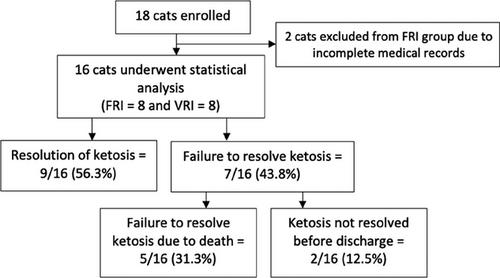Describe the use of fixed-rate intravenous insulin infusions (FRIs) in cats and dogs with diabetic ketoacidosis (DKA) and determine if this is associated with faster resolution of ketosis compared to variable-rate intravenous insulin infusions (VRIs). Secondary objectives were to evaluate complication rates, length of hospitalization (LOH), and survival to discharge (STD).
Randomized clinical trial (January 2019 to July 2020).
University veterinary teaching hospital and private referral hospital.
Dogs and cats with DKA and venous pH <7.3, blood glucose concentration >11 mmol/L (198 mg/dL), and β-hydroxybutyrate (BHB) concentration >3 mmol/L were eligible for inclusion. Patients were randomly assigned to receive either FRI or VRI.
Neutral (regular) insulin was administered IV as an FRI or VRI. For FRI, the rate was maintained at 0.01 IU/kg/h. For VRI, the dose was adjusted according to blood glucose concentration.
Sixteen cats and 20 dogs were enrolled. Population characteristics, mean insulin infusion rate, time to resolution of ketosis (BHB <0.6 mmol/L), complications, LOH, and STD were evaluated. In cats, overall resolution of ketosis was low (9/16 [56.3%]), limiting comparison of protocols. In dogs, resolution of ketosis was high (19/20 dogs [95.0%]) but the time to resolution in the FRI group was not different than that in the VRI group (P = 0.89), despite a 25% higher average insulin infusion rate in the FRI group (P = 0.04). The incidence of complications was low and did not differ between protocols. In cats, LOH and STD did not differ between protocols. All cats that died (5/16) did so within 78 hours and none had resolution of ketosis. Dogs receiving FRI had a shorter LOH (P = 0.01) but STD did not differ between protocols. Six dogs (30.0%) did not survive to hospital discharge but all had resolution of ketosis.
FRIs can be used in veterinary species but may not hasten resolution of ketosis.


